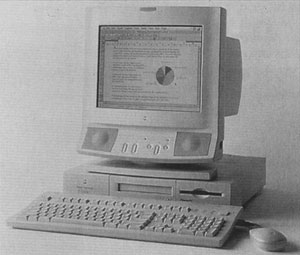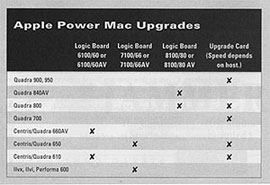 p3 p3 |
|
|
Putting theory aside, I asked former EM editor Bob O'Donnell to share the results of his hands-on Power Mac testing. In his current position as Macweek magazine's executive editor for reviews, O'Donnell tested several music applications on a prerelease Power Macintosh and reported no problems with Digidesign's Audiomedia II hard-disk recording hardware and Sound Designer II. Opcode's Studio Vision 1.44 contentedly handled digital audio and MIDI together, though with multiple windows open and an extreme zoom setting, it started to slow down. This would also be the case on a Quadra, though, so it can't really be considered a problem. Passport's Alchemy sample-editor required more memory than expected but then ran well. However, Macweek's Power Mac spontaneously rebooted whenever O'Donnell tried to launch Opcode's Galaxy 1.22. He attributes this to a conflict between the Power Mac's new floppy-disk handler and version 1.2.2's older copy-protection scheme. Galaxy 1.2.5 and Vision 2.0 have a new copy-protection method and ran with no problem. Eight-channel MIDI files played back correctly through both serial ports. So far, then, Apple's confidence in Power Mac's 68040 emulation seems well placed with regard to some popular, bellwether music programs. How fast programs will run under emulation is open to debate. Apple says that depending on how the application is written, you can expect anything from fast 68030 speed (i.e., a Ilci) to fast 68040 speed. Every other company I contacted said to expect emulation to run between IIci and Quadra 700 speed.
Going Native The vast majority of common applications use integer math, which is the type of calculation carried out by the computer's CPU. Word-processors, telecommunications programs, spreadsheets, and system operations such as screen redraws rely on integer math. Many digital-audio programs, such as those from Digidesign, depend on DSP cards to process audio. They mostly use the main CPU for the user interface and system calls, which require integer math. Accelerating integer calculations can speed up applications significantly. Apple says that ten percent of main processor routines-especially applications that heavily use the Macintosh operating system and Toolbox-account for 90 percent of the processor time. By accelerating these system routines, most OS-dependent applications should get a significant speed boost. To this end, System 7.1.2 includes native versions of PC Exchange 1.0.4, AppleScript 1.1, and (attention multimedia authors!) QuickTime 1.6.2. The new QuickTime should be much smoother, with better resolution and larger windows. In System 7.5, now in beta and due this summer, PowerTalk and, more important, QuickDraw GX, will be native code. QuickDraw is responsible for drawing the screen; any Mac user will immediately appreciate the relief of much faster redraws.
|
Power Upgrades Apple wasted no time announcing upgrade paths from its 68040 machines to PowerPC (see table below). All are available immediately. Logic-board upgrades include System 7.1.2, 8MB of DRAM, and the same interfaces, audio, and video support as the Power Mac model. DRAM for the upgraded system must be 72-pin, 80 ns or faster, installed in pairs. List prices: $999 for an upgrade to the 6100/60, $1,499 to the 7100/66, and $1,899 to the 8100/80. The AV logic-board upgrades cost an additional $100 to $400, depending on the model, and include the video I/O ports. Apple's user-installable, PDS-slot upgrade cards range in speed from 50 MHz to 66 MHz, essentially twice the clock speed of the motherboard (e.g., 66 MHz with a Quadra 650). They include 1 MB of SRAM (cache) and use the host computer's DRAM. They also use the host's ports, so the Power Mac AV video technologies are not supported. A Control Panel lets you boot from the host 68040 or the PowerPC 601. The PDS upgrades are a bargain, listing at $700. In addition, Daystar Digital, a long-time leading accelerator manufacturer, is initially offering two Power Mac PDS accelerators. These PowerPro 601 accelerators are available in 66 MHz (est. $1,500) and 80 MHz (est. $2,000) versions. They can go in any Mac with an in-line PDS and NuBus slot, including the Centris 650 and Quadra 650, 700, 800, 900, and 950. Support for the Ilci and other Mac platforms are expected by midyear. Daystar will also offer upgrades from its Turbo 040/040i accelerators. The PowerPro 601 uses Apple ROMs and PowerPC 601 chips but offers higher performance than Apple's PDS card. Unlike Apple, Daystar uses an asynchronous design, so its card runs at full speed in any compatible machine, rather than running at twice the host processor's speed. It has four 72-pin SIMM sockets, providing 128 MB of memory that works in addition to the host machine's memory. The PowerPro's data path is 64 bits, whereas the Apple card is 32 bits. Applications take advantage of this by loading into the accelerator's memory until it is filled, then using the host machine's RAM. A 1 MB static RAM cache, with the same specifications as Apple's, also is available (est. $500). A Control Panel lets you boot from the PowerPro 601 or the host CPU. Sometime in the second quarter of 1994, Daystar also will offer the nPOWER, a PowerPC 601 coprocessor card for multiprocessing applications. However, it is too soon to ascertain whether a PowerPC 601 coprocessor would offer significant advantages over a DSP coprocessor for running music software. Right now, the Motorola and AT&T DSP solutions still look good. ’ÄîSO |
return to top |
|

